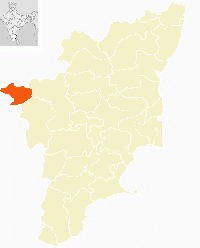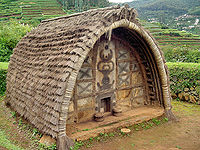Difference between revisions of "Nilgiris district" - New World Encyclopedia
Dan Davies (talk | contribs) (imported, credited, claimed) |
m (Robot: Remove claimed tag) |
||
| Line 1: | Line 1: | ||
| − | + | ||
<!--{{ pagenumbers | article }}—> | <!--{{ pagenumbers | article }}—> | ||
[[Image:TN Districts Nilgiri.gif|thumb|200px|Nilgiris district in Tamil Nadu, India]] | [[Image:TN Districts Nilgiri.gif|thumb|200px|Nilgiris district in Tamil Nadu, India]] | ||
Revision as of 13:12, 2 April 2008
The Nilgiris District is in the Indian state of Tamil Nadu. Nilgiri (Tamil : நீலகிரி or Blue Mountains when translated into English) is also the name given to a range of mountains spread across the states of Tamilnadu as well as Karnataka and Kerala. They are part of a larger mountain chain known as the Western Ghats. The highest point is the mountain of Doddabetta, with a height of 2,637 m. The district is mainly contained within this mountain range.
History
The Nilgiri hills have a history going back a good many centuries. It is not known why they were called the Blue Mountains. Several sources cite the reason as the smoky haze enveloping the area, while other sources say it is because of the kurunji flower, which blooms every twelve years giving the slopes a bluish tinge.
It was originally tribal land and was occupied by the Todas around what is now the Ooty area, and the by Kotas around what is now the Kotagiri area. The Badagas appeared here much later from the Mysore Plateau, the unconfirmed date being 1550. Although the Nilgiri hills are mentioned in the Ramayana of Valmiki (estimated by Western scholars to have been recorded in the second century B.C.E.), they remained all but undiscovered by Europeans until 1602. This was when the first European set foot into the jungles. A Portuguese priest going by the name of Ferreiri resolved to explore the hills and succeeded. He came upon a community of people calling themselves the "Toda." This priest seems to have been the only European to have explored this area. The Europeans in India more or less seem to have ignored the ghats for some two hundred or more years.
It was only around the beginning of the 1800s that the English unsuccessfully considered surveying this area. Around 1810 or so the East India Company decided to delve into the jungles here. An Englishman Francis Buchanan made a failed expedition. John Sullivan who was then the Collector of Coimbatore, just south of the Nilgiris, sent two surveyors to make a comprehensive study of the hills. They went as far as the lower level of Ooty, but failed to see the complete valley. The two men were Keys and Macmohan (their first names seem to be lost to the annals of history) and their mission was significant because they were the first Englishmen to set foot in the Nilgiri hills which soon led to the complete opening up of the area.
The original discovery however,is attributed to J.C.Whish and N.W.Kindersley, working for the Madras Civil Service, who made a journey in 1819 and who reported back to their superiors that they had discovered "the existence of a tableland possessing a European climate."
The first European resident of the hills was John Sullivan, the Collector of Coimbatore, who went up the same year and built himself a home. He also reported to the Madras Government the appropriateness of the climate; Europeans soon started settling down here or using the valley for summer stays. The complete valley became a summer resort. Later on the practice of moving the government to the hills during summer months also started.
By the end of the 19th century, the Nilgiri hills were completely accessible with the laying of roads and the railway line.
Main features
Tea is grown at elevations of 1,000 to above 2,500 metres. The area also produces eucalyptus oil and temperate zone vegetables. Parts of many Indian movies are filmed in the Nilgiris.
The altitude of the Nilgiris results in a much cooler and wetter climate than the surrounding plains, so the area is popular as a retreat from the summer heat. The rolling hills of the Downs look very similar to the Downs in Southern England, and were used for similar activities such as hunting.
The principal town of the area is Ootacamund, or Udhagamandalam. The town also has several buildings which look very "British", particularly the Churches. There is even a road junction known as Charing Cross.
The other main towns in the Nilgiris are Coonoor, Kotagiri, Gudalur and Aruvankadu. The famous tourist spot in Coonoor are Lamesrock and Sims park. In Sims park, a "Fruit Show" is conducted during summer. All the varieties of fruit are displayed during that time. This park is situated on the way of Kotagiri.
Ecoregions
Two ecoregions cover portions of the Nilgiris. The South Western Ghats moist deciduous forests lie between 250 and 1000 meters elevation. These forests extend south along the Western Ghats range to the southern tip of India. These forests are dominated by a diverse assemblage of trees, many of whom are deciduous during the winter and spring dry season. These forests are home to the largest herd of Asian Elephants in India, who range from the Nilgiris across to the Eastern Ghats. The Nilgiris and the South Western Ghats is also one of the most important tiger habitats left in India.
The South Western Ghats montane rain forests ecoregion covers the portion of the range above 1000 meters elevation. These evergreen rain forests are among the most diverse on the planet. Above 1500 meters elevation, the evergreen forests begin to give way to stunted forests, called sholas, which are interspersed with open grassland. These grasslands are the home to the endangered Nilgiri Tahr, which resembles a stocky goat with curved horns. The Nilgiri Tahrs are found only in the montane grasslands of the South Western Ghats, and number only about 2000 individuals.
Three national parks protect portions of the Nilgiris. Mudumalai National Park lies in the northern part of the range where Kerala, Karnataka, and Tamil Nadu meet, and covers an area of 321 km². Mukurthi National Park lies in the southwest of the range, in Kerala, and covers an area of 78.5 km², which includes intact shola-grassland mosaic, habitat for the Nilgiri tahr. Silent Valley National Park is just to the south and contiguous with these two parks, and covers an area of 89.52 km². Outside of these parks much of the native forest has been cleared for grazing cattle, or for plantations of tea, Eucalyptus, ganga and Acacia. The entire range, together with portions of the Western Ghats to the northwest and southwest, was included in the Nilgiri Biosphere Reserve in 1986, India's first biosphere reserve.
The region has given its name to a number of bird species, including the Nilgiri Pipit, Nilgiri Woodpigeon and Nilgiri Blackbird.
Demographics
It had a population of 762,141 as of 2001 and is 59.65% urbanised.[1] The district has a literacy of 81.44%, one of the highest in the state.
There are several tribes living in the Nilgiris, whose origins are uncertain. The best known of these are the Toda people, whose culture is based upon cattle, and whose red, black and white embroidered shawls, and silver jewelry is much sought after.
Tamil is the principal language spoken in the Nilgiris. Many people speak and understand English. Malayalam, Kannada & Hindi are also used to an extent. The Nilgiris is also home to the Toda language, spoken by the Toda people. As per the 2001 Census, Hindus formed the majority of the population (78.60%), followed by Christians (11.45%), Muslims (9.55%) and others (0.4%). .[2]
Transport
The Nilgiri Ghat Roads link the district with the nearest cities in Tamilnadu, Kerala and Karnataka. The Nilgiri Mountain Railway from Mettupalayam to Udhagamandalam via Coonoor, is a great tourist attraction. It was used in the film A Passage to India as the railway to the caves. It is a rack railway as far as Coonoor. The Nilgiri Mountain Railway, is now a UNESCO World Heritage Site.[3] This services many of the populated areas of the district including Coonoor, Wellington, Aruvankadu, Ketti, Lovedale and Ooty.
See also
- Badaga Hattis
ReferencesISBN links support NWE through referral fees
- ↑ Census 2001
- ↑ [1]
- ↑ http://whc.unesco.org/en/list/944/multiple=1&unique_number=1102 Official UNESCO list of World Heritage Sites - Mountain Railways of India]
External links
| |||||||||||||||||
| |||||||||||
Template:Western Ghats
Credits
New World Encyclopedia writers and editors rewrote and completed the Wikipedia article in accordance with New World Encyclopedia standards. This article abides by terms of the Creative Commons CC-by-sa 3.0 License (CC-by-sa), which may be used and disseminated with proper attribution. Credit is due under the terms of this license that can reference both the New World Encyclopedia contributors and the selfless volunteer contributors of the Wikimedia Foundation. To cite this article click here for a list of acceptable citing formats.The history of earlier contributions by wikipedians is accessible to researchers here:
The history of this article since it was imported to New World Encyclopedia:
Note: Some restrictions may apply to use of individual images which are separately licensed.






